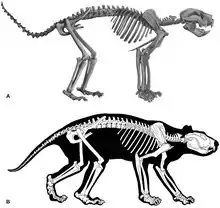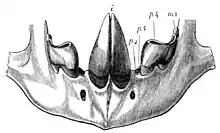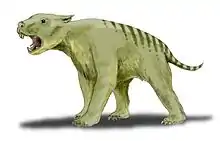Thylacoleonidae
Thylacoleonidae is a family of extinct carnivorous diprotodontian marsupials from Australia, referred to as marsupial lions.[2] The best known is Thylacoleo carnifex, also called the marsupial lion.[3] The clade ranged from the Late Oligocene to the Late Pleistocene, with some species the size of a possum and others as large as that of a leopard. As a whole, they were largely arboreal, in contrast to the mostly terrestrial dasyuromorphs (quolls only recently took the niches vacated by small thylacoleonids), monitor lizards and mekosuchines,[4] though members of Thylacoleo were likely primarily terrestrial with some climbing capabilities.[5]
| Thylacoleonidae Temporal range: | |
|---|---|
 | |
| Thylacoleo | |
| Scientific classification | |
| Domain: | Eukaryota |
| Kingdom: | Animalia |
| Phylum: | Chordata |
| Class: | Mammalia |
| Infraclass: | Marsupialia |
| Order: | Diprotodontia |
| Suborder: | Vombatiformes |
| Family: | †Thylacoleonidae Gill, 1872[1] |
| Genera | |
| |
Description

A diprotodontian family allied to the Vombatiformes, mammals that radiated and diversified in the Oligocene to Miocene. The thylacoleonid genera exhibit specialised dentition that allowed them to kill prey larger than themselves.
The earliest descriptions of the most recent species recognise the secateur-like blades of the teeth as a powerful mammalian predator, a "marsupial lion," that were noted as missing in the Australian environment. The third premolars exhibit this blade-like development, becoming greatly enlarged in the Pleistocene species Thylacoleo carnifex, prompting the description by Owen as "…one of the fellest and most destructive of predatory beasts."[6] They are seen as presumably occupying a trophic level as peak predators in their local ecologies, some smaller and arboreal climbers while those terrestrial species are sizably comparable to large dog or a big cat.
Distribution and habitat
The genera are associated with the late Oligocene and Miocene epochs. Microleo and Wakaleo have been located at the Lake Pitikanta fossil area in Central Australia and toward the northern coast at Riversleigh, below the gulf of Carpentaria, a rich source of fossil fauna. The most recent species, Thylacoleo carnifex, existed at least until the Pleistocene, the earliest known specimens of the family are dated to around twenty five million years ago.[7]
Taxonomy
Thylacoleontidae is considered a member of Diprotodontia, though its precise position within that group is uncertain. They have often been considered a basal group (often the most basal group) within Vombatiformes, making their closest living relatives wombats and koalas,[8] though other authors have placed them at the base of Diprotodontia, outside of either Vombatiformes, Phalangeriformes or Macropodiformes.[9]
The family was described by Theodore Gill in a systematic revision of mammalian taxa published by the Smithsonian Institution in 1872.[1] The name is derived from the genus named by Richard Owen, Thylacoleo, which he recognised as a potent carnivore and described as marsupial version of the modern lions (Leo).
A revision of the family was published in 2017, enabled by the discovery of a skull of an early species, named as Wakaleo schouteni, which allowed closer comparison with previously described species and the more complete fossil record of the lineages. The study by Anna Gillespie, Mike Archer and Suzanne Hand, revised the description of Wakaleo to include a new species and circumscribe taxa previously assigned to Priscileo.[6]
Classification
Five genera are currently accepted as belonging to this family:[10]
- Genus Enigmaleo
- Enigmaleo archeri (Early Miocene)[11]
- Genus Lekaneleo
- Lekaneleo myersi (Middle Miocene)[11]
- Lekaneleo roskellyae (Early Miocene)
- Genus Microleo
- Microleo attenboroughi (Early Miocene)[12]
- Subfamily Thylacoleoninae
- Genus Thylacoleo
- Subfamily Wakaleoninae
- Genus Wakaleo
- Wakaleo pitikantensis (Late Oligocene)
- Wakaleo schouteni (Late Oligocene—Early Miocene)
- Wakaleo oldfieldi (Early Miocene—Late Miocene)
- Wakaleo vanderleuri (Middle Miocene—Late Miocene)
- Wakaleo alcootaensis (Late Miocene)
- Genus Wakaleo
References
- Gill, Theodore (1872). "Arrangement of the families of mammals. With analytical tables. Prepared for the Smithsonian institution". Smithsonian Miscellaneous Collections. Smithsonian Institution. 11: 1–98.
- Werdelin, L (1988). "Circumventing a Constraint - the Case of Thylacoleo (Marsupialia, Thylacoleonidae)". Australian Journal of Zoology. 36 (5): 565. doi:10.1071/ZO9880565.
- Wroe, Stephen. "Move Over Sabre-Tooth Tiger". Australian Museum. Archived from the original on 2003-03-10. Retrieved 2008-06-03.
- Gillespie, Anna K.; Archer, Michael; Hand, Suzanne J. (2016). "A tiny new marsupial lion (Marsupialia, Thylacoleonidae) from the early Miocene of Australia" (PDF). Palaeontologia Electronica. Palaeontological Association. 19 (2.26A): 1–26. doi:10.26879/632. Retrieved 29 August 2016.
- Figueirido, Borja; Martín-Serra, Alberto; Janis, Christine M. (August 2016). "Ecomorphological determinations in the absence of living analogues: the predatory behavior of the marsupial lion ( Thylacoleo carnifex ) as revealed by elbow joint morphology". Paleobiology. 42 (3): 508–531. Bibcode:2016Pbio...42..508F. doi:10.1017/pab.2015.55. hdl:1983/1f3ac566-0b08-48fb-b27c-63fe4256c138. ISSN 0094-8373. S2CID 87168573.
- Gillespie, A.K.; Archer, M.; Hand, S.J. (6 December 2017). "A new Oligo–Miocene marsupial lion from Australia and revision of the family Thylacoleonidae". Journal of Systematic Palaeontology. 17 (1): 59–89. doi:10.1080/14772019.2017.1391885. S2CID 90758394.
- Gillespie, A. (7 December 2017). "A new species of marsupial lion tells us about Australia's past". The Conversation.
- Beck, Robin M. D. (2023), Cáceres, Nilton C.; Dickman, Christopher R. (eds.), "Diversity and Phylogeny of Marsupials and Their Stem Relatives (Metatheria)", American and Australasian Marsupials, Cham: Springer International Publishing, pp. 1–66, doi:10.1007/978-3-030-88800-8_35-1, ISBN 978-3-030-88800-8, retrieved 2023-09-06
- Beck, Robin M.D.; Voss, Robert S.; Jansa, Sharon A. (2022-06-28). "Craniodental Morphology and Phylogeny of Marsupials". Bulletin of the American Museum of Natural History. 457 (1). doi:10.1206/0003-0090.457.1.1. ISSN 0003-0090.
- Haaramo, Mikko. "Diprotodontia - diprotodonts". Mikko's Phylogeny Archive. Retrieved 2007-12-29.
- Gillespie, A. K. (2023). "Two new marsupial lion taxa (Marsupialia, Thylacoleonidae) from the early and Middle Miocene of Australia". Alcheringa: An Australasian Journal of Palaeontology: 1–16. doi:10.1080/03115518.2022.2152096. S2CID 256157821.
- Gough, Myles (25 August 2016). "Kitten-sized extinct 'lion' named after David Attenborough". BBC News. Retrieved 29 August 2016.

.jpg.webp)